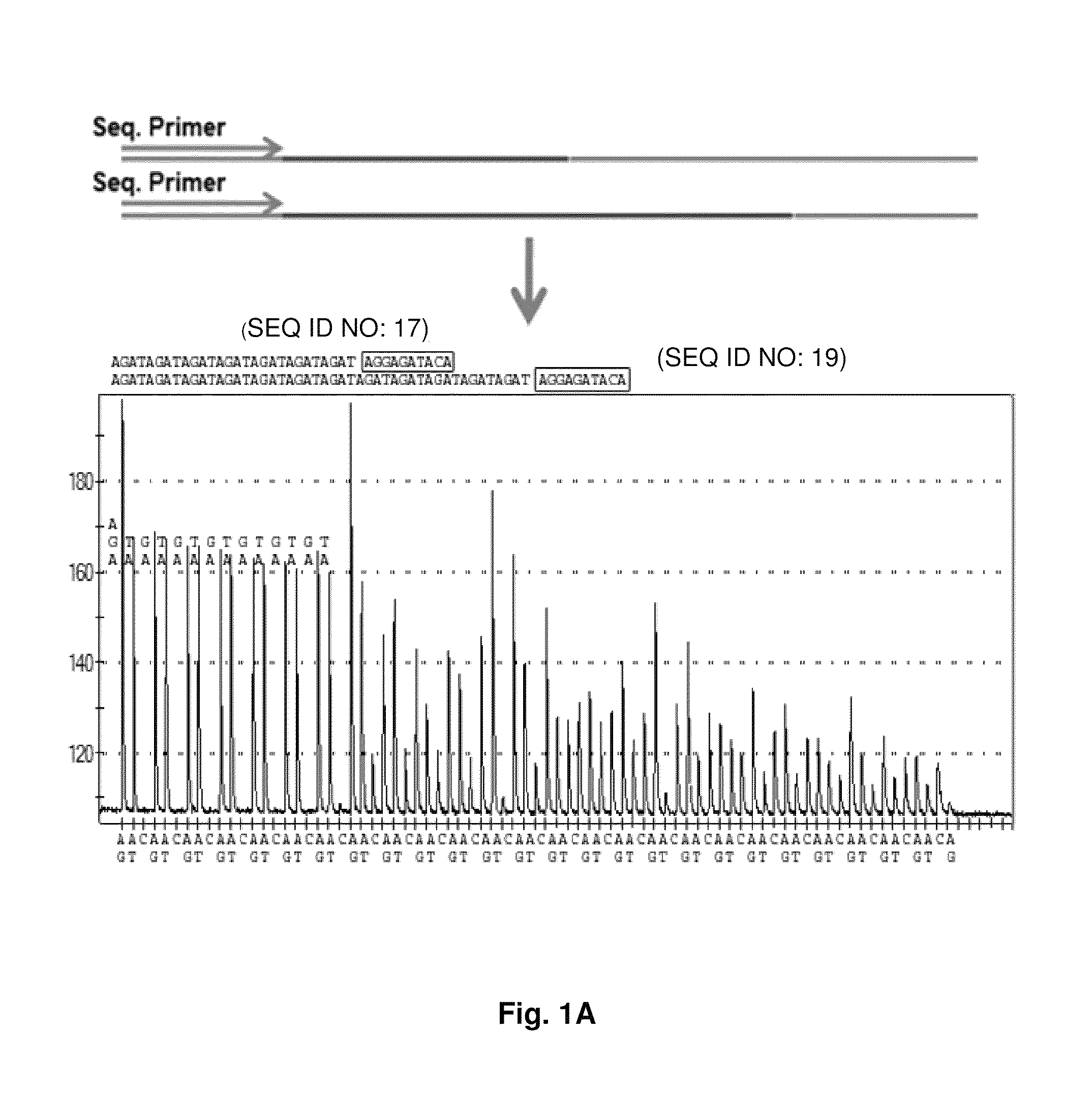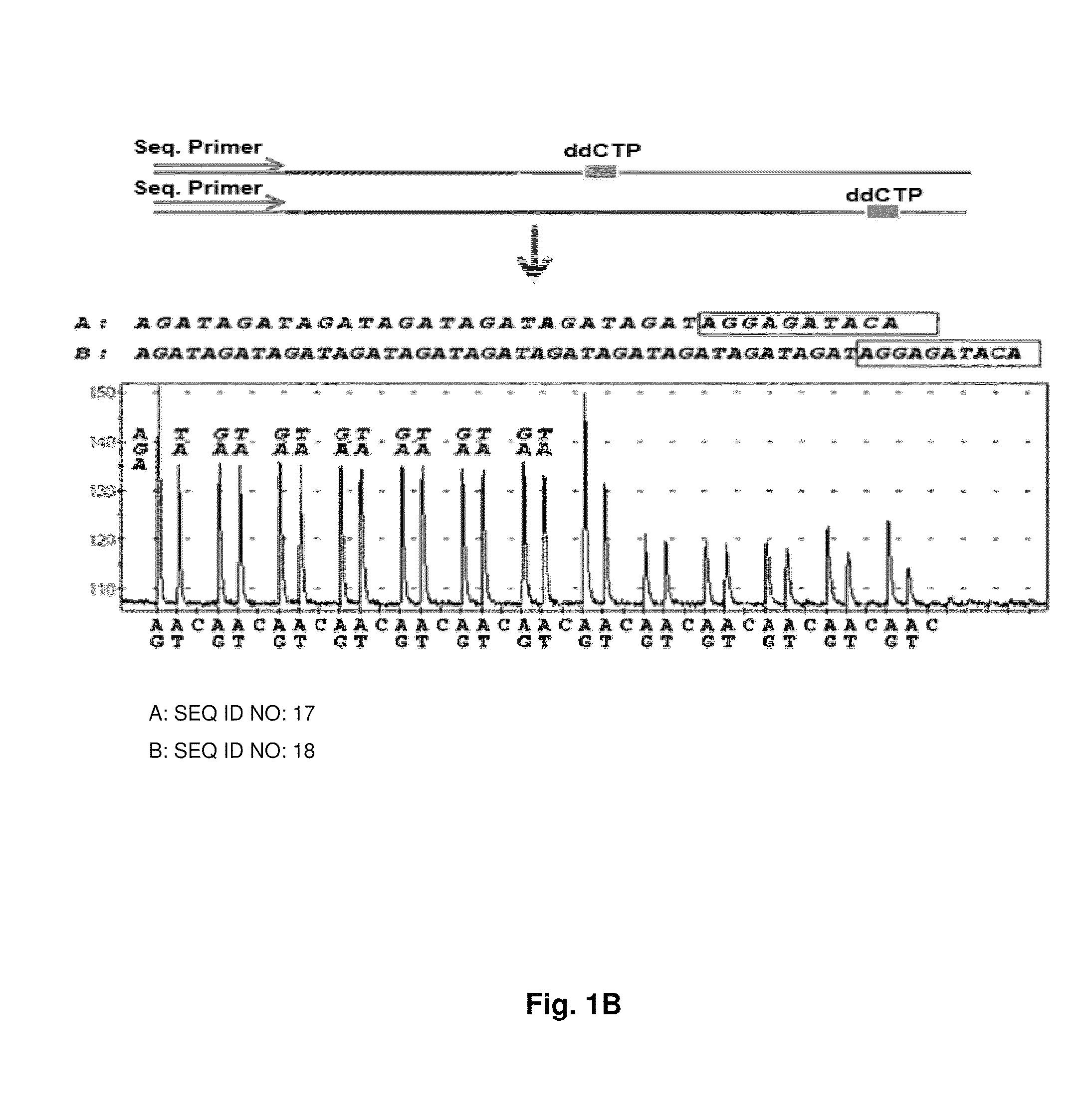DNA template tailoring using PNA and modified nucleotides
a pna and nucleotide technology, applied in the field of dna sequencing and gene analysis, can solve the problems of complex informatics, short read length, and relatively short length of dna reads using most approaches, and achieve faster, more accurate, reliable, rapid, information-rich and cost-effective approaches, and reduce analysis time by half
- Summary
- Abstract
- Description
- Claims
- Application Information
AI Technical Summary
Benefits of technology
Problems solved by technology
Method used
Image
Examples
example 1
Probe and Primer Design and Synthesis
[0079]Oligonucleotides for amplification of the markers GATA172D05, GATA31E08 and HPRTB (Genbank accession no. M26434; 12 repeats) were designed by using primer3 software (http(colon slash slash) primer3.sourceforge.net) and were synthesized by IDT (Coralville, Iowa, USA). Either the forward or reverse primer was biotinylated. The sequences for oligonucleotides are shown in Table 2.
[0080]
TABLE 2The dye-labeling, sequences for amplification and sequencing oligonucleotides as well as PNA probes used for pyrosequencing.DyeSEQ IDMarkerLabeling*NO:Primer SequencesAmplification Biotin 55′-Biotin / ataattgaaagcccggattcprimer- 65′-tagtggtgatggttgcacagGATA172D05Seq. primer-No 75′-gtgatggttgcacagatataGATA172D05labelingPNA ProbeNo 8N-Terminus-gctatatcaatacct-C-TerminusGATA172D05labelingAmplification Biotin 95′-Biotin / cagctgacagagcacagagaprimer-105′-aggggagaaggctagaatgaGATA31E08Seq. primer-No115′-agatagatgatagggagggGATA31E08labelingPNA ProbeNo12N-Terminus-agat...
example 2
PCR Amplification and Sample Preparation
[0086]Fifteen blood samples were purchased from Stanford Blood Centre (Palo Alto, Calif., USA). Total Genomic DNA (gDNA) was extracted using Qiagen's QiaAMP DNA Blood Maxi Kit (www-dot-qiagen.com). Extractions were performed according to manufacturer's instructions. The quantity of DNA was determined by NanoDrop (Thermo Scientific, Wilmington, Del.) as per manufacturer's recommendation.
[0087]10 ng of gDNA was amplified in a single-plex PCR using biotin labeled primers in a 50 μl reaction volume containing; 10 ng of genomic DNA, 0.2 μM each forward and reverse primer for all three markers, 75 mM Tris HCl (pH 8.0), 2.0 mM MgCl2, 200 μM of each dNTPs, 1.5 U of AmpliTaq Gold polymerase (Applied Biosystems, Foster City Calif., USA). The amplification was performed in a Gene Amp PCR System 9700 Thermal Cycler (Applied Biosystems, Foster City, Calif.) at the following conditions: 95° C. for 10 minutes, followed by 32 cycles of denaturing at 95° C. fo...
example 3
Combinatorial Pyrosequencing
[0090]The Pyrosequencing reaction was performed at 28° C. in 40 μl of reaction volume using an automated PSQ 96 system (Biotage, Uppsala, Sweden). The final volume of 40 μl contained primed target DNA, 30 μl of 1× annealing buffer (0.1 M Tris-acetate pH 7.75, 200 mM magnesium acetate), 5 μl of standard Enzyme mix and 5 μl of standard substrate mix provided by Biotage (www.biotage.com). The dGTP and dATPαS were mixed in equal volume to dispense together allowing polymerase to add two nucleotides at a time during sequencing. Likewise dTTP and dATPαS were also mixed in equal volume to dispense together to interrogate next two bases in template sequence using combinatorial approach. The terminating nucleotide (ddCTP) was purchased from USB Corporation (Cleveland, Ohio, USA) and used in the Pyrosequencing reaction.
[0091]In the combinatorial pyrosequencing approach, we dispensed two nucleotides at once to incorporate two bases at a time as a repeat pattern for ...
PUM
| Property | Measurement | Unit |
|---|---|---|
| volume | aaaaa | aaaaa |
| pH | aaaaa | aaaaa |
| pH | aaaaa | aaaaa |
Abstract
Description
Claims
Application Information
 Login to View More
Login to View More - R&D
- Intellectual Property
- Life Sciences
- Materials
- Tech Scout
- Unparalleled Data Quality
- Higher Quality Content
- 60% Fewer Hallucinations
Browse by: Latest US Patents, China's latest patents, Technical Efficacy Thesaurus, Application Domain, Technology Topic, Popular Technical Reports.
© 2025 PatSnap. All rights reserved.Legal|Privacy policy|Modern Slavery Act Transparency Statement|Sitemap|About US| Contact US: help@patsnap.com



